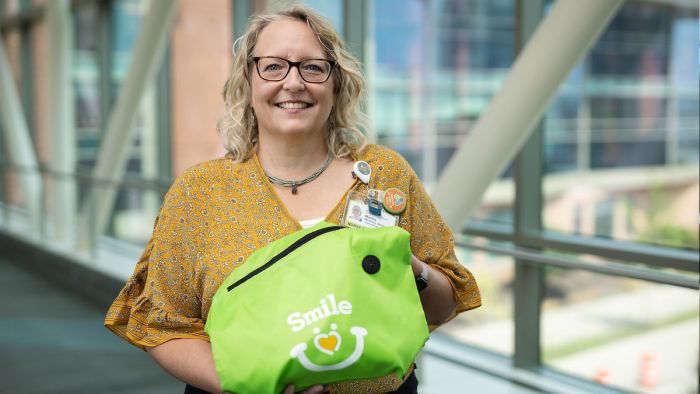A simple tote bag from Gillette Children's is proving to be a powerful tool.
The tote bag contains a collection of tools and educational materials to support parents of children who need cleft lip and/or palate repair. The carefully designed “Smile Bags” are a way for the Gillette craniofacial team to reach out to parents who might be feeling anxious and overwhelmed by their new baby’s diagnosis. The bags are handed out during prenatal visits or shortly after parents receive their child’s diagnosis.
“It really is a nice first step on our journey with these parents,” says Gillette advanced pediatric nurse practitioner, Martha McGrory. “It’s a way to show families that we’re there for them and are happy to help.”
McGrory is part of a team of three advanced pediatric nurse practitioners (APRNs) at Gillette that includes Anna Rauch. These APRNs are experts in feeding babies who have cleft lip and palate and have privileges at many of the Twin Cities metro area hospitals which allows them to visit the hospital just after a mother has delivered her baby. “Our first step is to congratulate the parent,” says Anna Rauch. “We then spend time watching the baby eat and providing guidance and we answer any questions.”
Babies born with cleft issues might have feeding concerns and may need to use a special bottle or nipple. The Gillette “Smile Bag” has a Dr. Brown specialty bottle and nipples (levels 1 and 2). Dr. Brown is one of the most common specialty bottles used for children with cleft lip and palate. It also contains a special pacifier with a clip, a burp cloth, bib and information about what to expect when caring for a child who has a cleft lip and/or palate.
“Many families have questions about what to expect when their child is born with a cleft lip and/or palate such as what their child will look like and what type of surgery is needed,” Rauch says. “It is normal for parents to also have concerns about how to feed their baby with a cleft lip and/or palate and how the cleft will affect their child long-term such as socially and developmentally.”
Gillette has one of the largest craniofacial programs in the country. The team at Gillette includes craniofacial and pediatric plastic surgeons, neurosurgeons, dentists, orthodontists, speech-language pathologists, advanced practice pediatric nurse practitioners, audiologists, dieticians and feeding specialists. The American Cleft Palate Association has certified Gillette as a site for cleft care.
One of the hallmarks of craniofacial care at Gillette is the team approach to creating a unified, cohesive plan for each child. Pediatric craniofacial and plastic surgeon, Jo Barta, MD, has experience caring for children who have craniofacial concerns. She wants providers to know Gillette can be their craniofacial partner every step of the way. “We develop an ongoing relationship with families,” Barta says. “The first year is certainly the most important year for cleft lip and palate care, but the long-term follow-up to monitor speech as well as growth and development through all the stages of life is part of proper cleft care. At Gillette, we can monitor and make recommendations to families and their primary care providers."
Barta hopes parents appreciate the care and thought that went into creating the “Smile Bags” and adds the real key is the opportunity for parents to be introduced to the craniofacial team at Gillette. “Martha and Anna are awesome members of the team. The skills they bring and the importance of having three well-educated, skilled nurse practitioners who are also feeding experts should be reassuring not only to families but also to primary care providers who may not be as familiar with the day-to-day complexities of a cleft lip and palate diagnosis.”
Get Partners in Care Stories in your inbox!
Subscribe to Partners in Care Journal, a newsletter for healthcare providers and community health professionals.
Subscribe Today Home Page
Home Page



